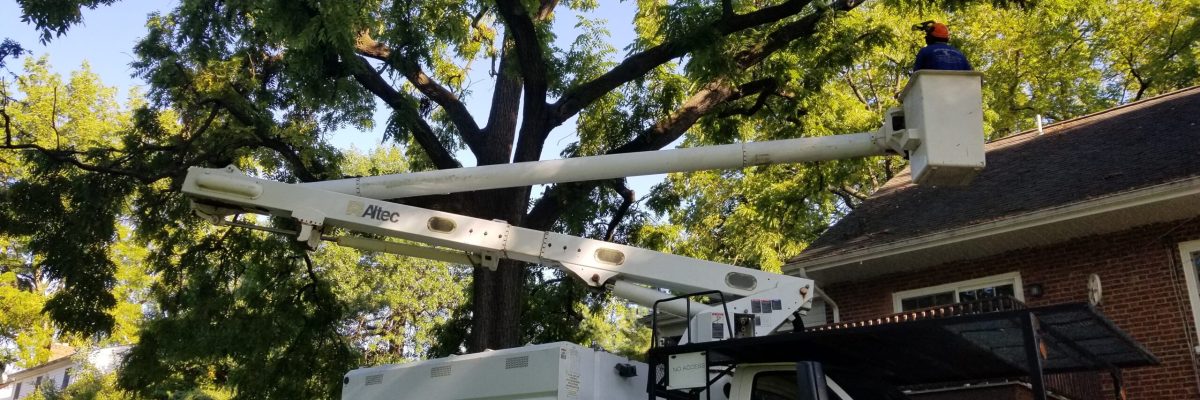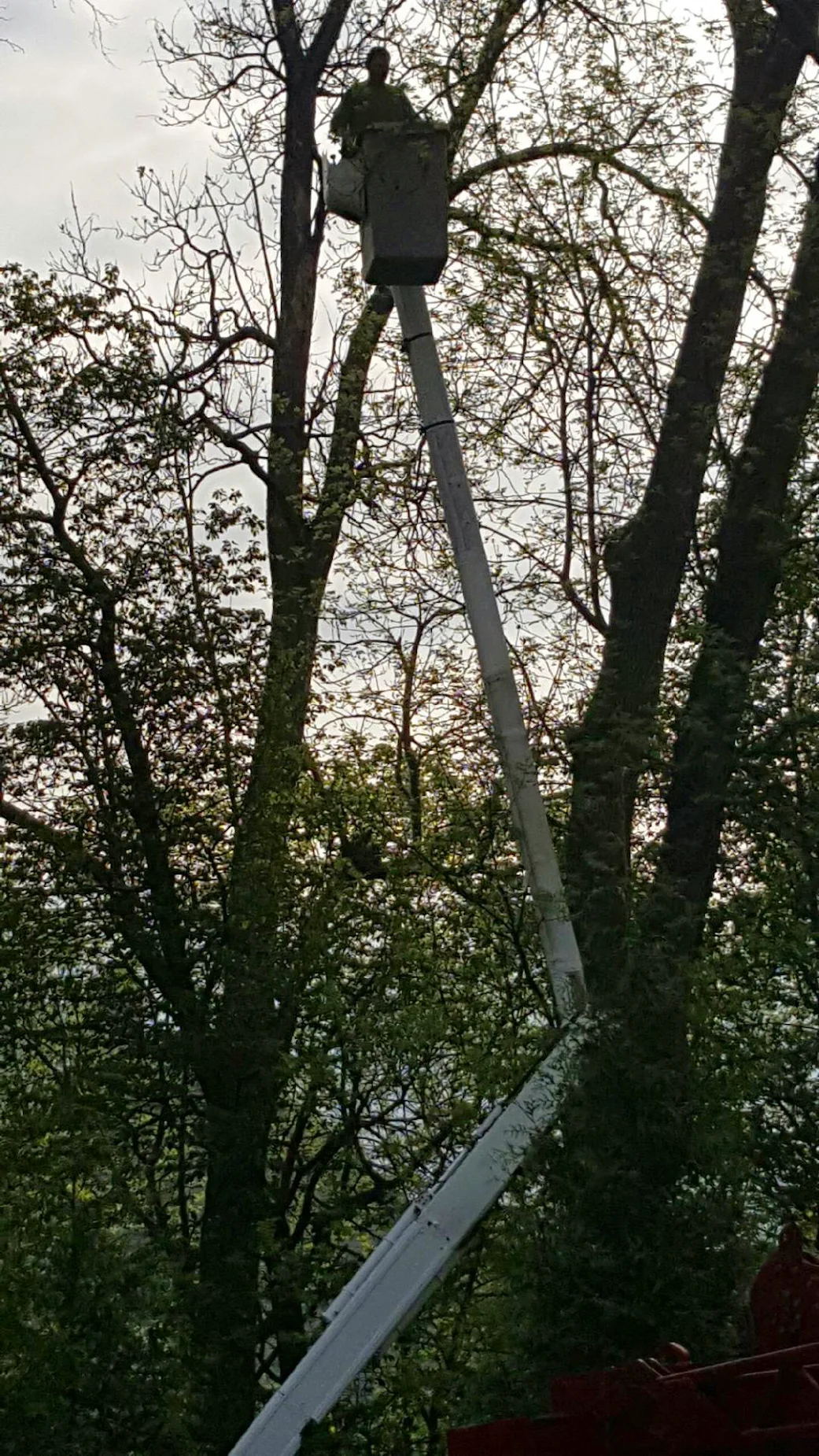Professional Tree Trimming & Pruning Services in Lancaster, PA

Service Overview
Need tree trimming or pruning in Lancaster, PA? Our certified arborist provides expert care for healthier trees. Request a free estimate today! Is your yard looking a bit overgrown? Maybe those once beautiful trees are blocking the view, or you’re starting to worry about heavy branches hanging above your house. Regular tree trimming is key to not only making your property look its best but also keeping your trees healthy and safe.
Why Choose Douglas Tree Service?
When it comes to tree care, experience matters, we don’t just “know” trees—we live and breathe tree care. Robert Douglas, a certified arborist and Penn State graduate with degrees in arboriculture, leads our team with over 20 years of hands-on experience. There’s no substitute for the knowledge and skills that come from working on countless properties throughout Lancaster County. Douglas Tree Service – Your trusted tree care experts in Lancaster, PA.
We’ve seen and dealt with it all. From delicate pruning of ornamental trees to heavy-duty trimming of giant oaks, our team is prepared for any challenge. We’ve worked with trees showing signs of disease, dead branches that threaten property, and trees that simply need a shape-up. Our knowledge ensures that we trim trees in a way that promotes long-term health, not just temporary aesthetic improvements.
Whether it’s a large tree that’s lost major limbs or a shrub that’s overgrown, our expert team knows how to prune in a way that promotes healthy regrowth.
📞 Call today for a free estimate and expert tree trimming services in Lancaster, PA!
Expert Tree Trimming Services for Healthy Growth and Safety
Our Tree Trimming Services Include:
- Precision Pruning & Shaping – Remove overgrown or dead branches.
- Storm Damage Cleanup – Trim broken limbs for safety.
- Canopy Thinning – Improve light penetration & airflow.
- Deadwood Removal – Prevent disease & hazards.
Pruning objectives:
Our tree trimming and pruning practices are carefully designed around a set of key objectives that ensure your trees not only look beautiful but also remain healthy and safe. By following professional standards, we focus on maintaining the natural structure of your trees while preventing potential hazards or issues down the line.
- Improving branch and trunk architecture.
- While promoting or subordinating certain leaders, stems, or branches.
- Promote desired branch spacing.
- Promote or discourage growth in a particular direction (directional pruning).
- Minimize future interference with traffic, lines of sight, infrastructure, or other plants.
- Restoring plants following damage; and/or rejuvenate shrubs.
Navigating Complex Tree Care Issues? Let Our Expert Team Provide Tailored Solutions
At Douglas Tree Service, we specialize in addressing the unique challenges your trees may face. Our professional team offers customized solutions to maintain the health, safety, and beauty of your trees. Whether you’re dealing with overgrown limbs, structural issues, or disease, we’ve got you covered.
Here’s how we help with real-life examples:
Removing branches that rub against each other:
A client in Lititz had a beautiful oak tree with two large branches rubbing against one another. Over time, the friction caused the bark to wear down, exposing the tree to potential infections. Our team carefully removed one of the branches to prevent further damage, allowing the oak to heal and thrive without risking disease.
Eliminating limbs that interfere with structures:
In East Petersburg, a homeowner contacted us because branches from a maple tree were brushing against their roof, damaging shingles and obstructing their chimney. We safely removed the interfering limbs, protecting the home while preserving the natural beauty of the tree.Removing dead or damaged branches:
A commercial property in Manheim had several large trees with dead limbs hanging over a parking lot. These branches posed a serious hazard to employees and visitors. Our team quickly removed the dead limbs, ensuring the safety of the property and preventing further decay of the trees.Addressing disease-infected or insect-infested limbs:
In Lancaster, we responded to a homeowner who noticed strange discoloration and holes in the branches of their ash tree. After diagnosing the issue as an emerald ash borer infestation, we pruned the affected branches and applied insecticide to stop the spread, saving the tree from further destruction.Improving tree structure:
A client in Mount Joy had a large pine tree with uneven growth, causing one side to become top-heavy and vulnerable to wind damage. We rebalanced the tree by pruning excess branches on one side, reducing wind resistance and decreasing the chances of storm damage.Removing weather-damaged limbs:
After a severe storm in Quarryville, a large Beech tree on a homeowner’s property lost several limbs and was leaning dangerously. Our team removed the damaged limbs and stabilized the tree with cabling, ensuring it wouldn’t pose a threat to the home or family.Thinning branches:
In Lititz, a client had a dense, overgrown tree in their backyard that blocked sunlight from their garden. We carefully thinned out the tree’s branches to increase light penetration, improving the health of both the tree and the plants below.Shaping trees for aesthetics:
A homeowner in Lancaster wanted their ornamental cherry tree pruned to create a more symmetrical and visually pleasing shape. Our team worked to enhance the tree’s natural form, resulting in a beautiful focal point for their front yard while ensuring healthy growth.- Provide clearance and enhancing views:
Why Choose Us?
- Over 20 years of experience in Lancaster County
- Certified arborist-led tree care
- Safe efficient trimming with a 60ft bucket truck
- Fully licensed & insured
Service Areas in Lancaster, PA
we proudly offer professional tree trimming and pruning services throughout Lancaster County, PA. Whether you’re in the heart of Lancaster City or in the surrounding suburbs, our team is ready to help keep your trees healthy, safe, and looking their best.
We serve the following areas in Lancaster County, PA:
- Lancaster City
- Lititz
- Manheim
- Ephrata
- Elizabethtown
- Mount Joy
- Columbia
- Millersville
- East Petersburg
- Willow Street
- Strasburg
- Leola
- New Holland
- Gap
- Denver
- Akron
- Quarryville
- Bird-in-Hand
- Ronks
- Intercourse
- Paradise
- Brownstown
No matter where you are in Lancaster County, our certified arborist and skilled team are ready to provide expert tree care.
Why Regular Tree Trimming Is Essential
Did you know that neglecting tree trimming can lead to costly repairs or safety hazards? Not to mention, trees that are left to grow wild can quickly become unmanageable, leaving you with more work in the long run. Regular trimming not only keeps your landscape looking sharp but also:
- Promotes Tree Health: Removing dead or diseased branches helps prevent the spread of disease and keeps your trees thriving.
- Prevents Storm Damage: Overgrown trees are more susceptible to damage during storms. Trimming them before winter arrives can save you from property damage down the road.
- Boosts Curb Appeal: A well-trimmed tree instantly enhances the appearance of your home or business, making your property more inviting.
How We Work: Our Process
When you call us, we don’t just show up and start cutting. We’re committed to delivering the best results, which means starting with a thorough evaluation of your trees and your property.
Our process is simple:
- Free Consultation: We come to your property and assess your trees’ needs.
- Personalized Solutions: After discussing your goals, we offer customized trimming plans to meet your expectations.
- Professional Execution: Our licensed and insured team safely trims your trees with precision, ensuring your property is left clean and looking better than ever.
We’ve built our reputation on trust, reliability, and quality service, so you can count on us to get the job done right.
Real Stories from Lancaster County
Here’s one of our favorite success stories: A family in Lancaster County had hedges and trees so overgrown, they felt like their house was disappearing! They were concerned about the branches hitting their windows during storms and blocking their view. We trimmed everything back, shaped the hedges, and now their home is not only safer but also looks stunning. Their neighbors even commented on the transformation!

Let us give you a FREE estimate!
We will come to your property, evaluate & recommend the tree work requested. There is no cost or obligation to you!
Tree Trimming Costs in Lancaster County, PA
One of the most common questions we get is, “How much does tree trimming cost?” It’s a fair question—and after working with trees of all shapes and sizes for over two decades, I can tell you, there’s no one-size-fits-all answer. But don’t worry, I’ll break it down for you. We always make sure our clients understand exactly what they’re paying for, so there are no surprises. Sound good?
From my years in the field, I can tell you that a few key factors affect the cost of tree trimming. Let’s take a closer look at what could influence your final bill:
- Tree Size & Height: Larger, taller trees typically require more time, equipment, and manpower.
- Type of Trimming: A simple pruning is usually less expensive than crown reduction or deadwood removal.
- Accessibility: Trees close to structures or in hard-to-reach areas may involve additional labor and safety precautions.
- Condition of the Tree: If your tree is damaged, diseased, or dying, it may require special care to handle safely.
Average Tree Trimming Costs in Lancaster County, PA
So, what should you expect to pay? On average, tree trimming in Lancaster County costs anywhere from $250 to $1,000 per tree. I know, it’s a wide range, but I’ll explain why.
Small Trees (Under 30 feet): $250 – $400
- Ideal for ornamental trees or smaller trees that require light pruning or shaping.
Medium Trees (30 to 60 feet): $400 – $700
- This applies to trees like maples or oaks that require more extensive trimming but are still accessible.
Large Trees (Over 60 feet): $700 – $1,000 or more
- These larger trees often require specialized equipment and more labor, especially if they’re close to structures or power lines.
Of course, these are just ballpark figures based on the typical projects we handle. The truth is, every tree is unique—just like its owner. That’s why the best way to get an accurate quote is to schedule a free consultation. We’ll come out, take a close look, and give you a fair, transparent price based on your specific situation.
Ready to Trim Your Trees?
Don’t wait until a heavy branch crashes through your roof or your landscape gets out of hand. Fall is the perfect time to trim your trees before winter weather hits. Whether you’re looking for a simple prune or need a major trim job, we’re here to help.
Contact us today for a free consultation and let’s discuss how we can improve the health and beauty of your trees. At Douglas Tree Service, we care for your landscape as if it were our own!
Conclusion: Why Douglas Tree Service?
In summary, our tree trimming and pruning services are more than just cosmetic. They are grounded in key objectives that keep your trees healthy, safe, and beautiful. We follow best practices to ensure that each cut is made with precision, promoting the long-term health and structural integrity of your trees. When you choose us, you’re choosing a team with over 20 years of experience, certified expertise, and a passion for tree care. We’ve built a reputation in Lancaster County for delivering high-quality, reliable services, and we’d love the opportunity to show you why we’re trusted by so many.
Reach out today, and let’s get started on creating a safe, beautiful, and healthy landscape for your property!

